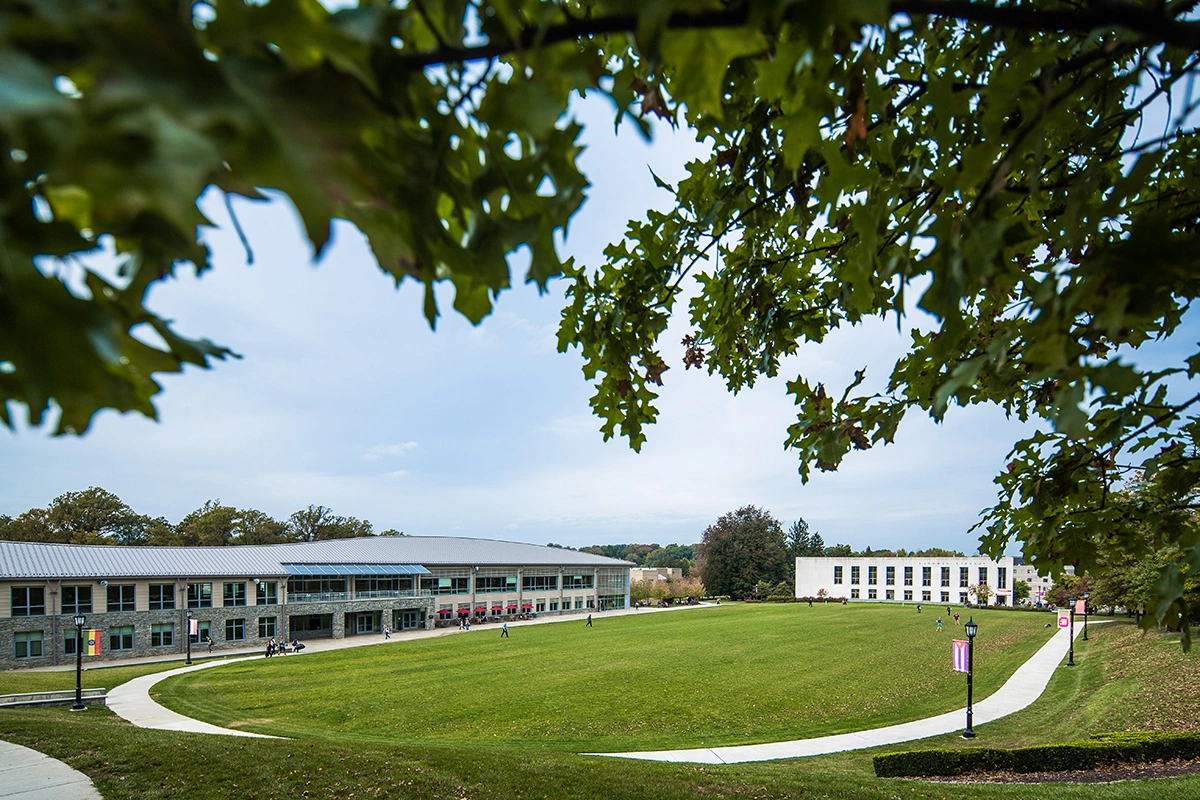It’s Not Easy Being Green, But Arcadia Proves It’s Up to the Task
First celebrated in 1970, Earth Day happens annually on April 22 to raise awareness for the need to protect the environment. We each have a part to play in this endeavor, and Arcadia University is no different.
Around the Glenside campus–from the Commons to the residence halls, from the Castle to the Dining Hall and everywhere in between–there are many sustainable efforts to highlight.

University Commons
It’s safe to say that the Commons is a “smart” building.
The windows? Many can open and close themselves to provide outside air to the building when they sense the pre-programmed need.
The lights? They can sense how bright it is outside and decide if there’s enough light coming in, turning themselves on if there is not.
The conference rooms? Occupancy sensors decide if the lights in certain areas need to be on if no one is around. There is also high-definition video conferencing that brings global excellence to Arcadia from around the globe in nanoseconds without a carbon footprint.

Solar panels line the area above the balcony, providing self-generated electricity by harvesting sunlight. The metal roof on the Commons is designed to accept more solar panels in the future.
Outside of the building, an underground system captures and holds rainwater runoff from the roof of the Commons for irrigation of local plant material upon demand. The stormwater retention basin under Haber Green was built with 20 percent additional capacity for future building needs.
Residence Halls
Ever notice a dumpster outside your residence hall to collect the trash? Nope. And that’s because each morning, Arcadia’s Facilities staff begins their day by taking each building’s trash out to the curb, where it’s then transported to the trash and recycling compactors.
“The added benefit of this program is twofold,” explained Tom Macchi, associate vice president of Facilities Management and Capital Planning. “Our campus does not have unsightly dumpsters outside every building, which can also be blowing trash magnets. And, we are able to monitor, control and ensure, in real-time, that all recyclable materials are being recycled, and trash ends up where it belongs–in the trash.
Speaking of recycling, at the end of each academic year, the Facilities staff takes left-behind clothes, books, furniture, and other items to various charities in the area to prevent as much waste as possible.

Several residence halls now have high efficiency, hotel type air conditioning units. These units work well in lieu of a total building cooling system that must cool the whole building whether someone lives there or not. These individual units provide a significant and practical way to save energy.
“And we still have window screens if you still want to go ‘old school’ with outside ventilation,” Macchi joked. “We encourage that, of course!”
Grey Towers Castle
Like some sustainability efforts, the work in Grey Towers Castle might be hard to see. However, that does not mean it isn’t happening.
High-efficiency fans have been installed throughout the building so that in the summer, it’s cooled by a natural updraft, eliminating the need for constant use of air conditioning.
“These fans have reduced the Castle attic temperature by 20 degrees in the summer, and the cooling effects are noticeable throughout the building as there is a constant gentle air flow,” notes Macchi.

More than 1,400 trees have been planted around campus over the last 10 years, most notably around the Castle and the Walk of Pride. The University is repopulating locations with the original species that were once planted there. In addition, in lieu of cutting down trees, the University tries to transplant as many trees as possible to other parts of campus.
Dining
To be sustainably responsible, you need to have good partners. One of Arcadia’s strongest sustainability partners is Metz, our food services provider. Metz’s efforts include:
- Sourcing organic and locally produced foods to build menus around fresh, local produce and ingredients.
- Offering hormone-free milk and fair trade coffee and other options, such as cage-free eggs.
- Practicing water and energy conservation by offering Energy Star equipment and conducting routine audits to identify opportunities to reduce output
- Using biodegradable food and beverage containers, napkins, and trash bags
- Using environmentally friendly cleaning agents and recycled cleaning materials like mop heads made from recycled plastic with handles from renewable bamboo
In the Dining Hall, the University has replaced a 500-gallon hot water heater with an 80-gallon high-efficiency gas hot water heating system. This system not only heats the domestic water, but also heats the building for a significant savings on energy and natural gas.
It’s not just the flashy, big-ticket items that contribute to Arcadia’s sustainability efforts. As Macchi notes, the minutiae of day-to-day impacts the environment too.
“Simply properly maintaining all mechanical systems throughout the year–ensuring that they are tuned up and operating at peak efficiency–is a green contribution,” he explained. “Fixing all drippy faucets, leaky pipes in mechanical rooms, and replacing old pumps with high efficiency pumps are just a few examples.”
In the end, Macchi knows that the effort will be worth it in the long run.
“If we, now, expend just a bit more mental energy, pay a little more attention, be curious about everything we do and how can we truly do it better, then couple this thoughtful approach and behavior with results-driven physical work, we can significantly conserve our natural resources, protect our environment, and ultimately leave this world in better shape for those who come after us.”


